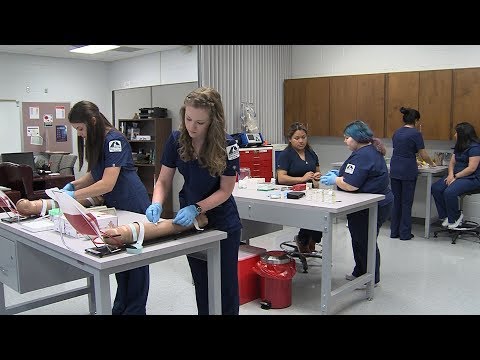How Much Does a Medical Assistant vs LPN Make?
Contents
Medical assistants and licensed practical nurses (LPNs) both provide basic patient care under the supervision of a physician. But how much does each profession earn? Here’s a comparison of medical assistant vs LPN salaries.
Checkout this video:
Job Description
A medical assistant is a multi-skilled professional who supports the work of physicians and other health professionals. They perform both clinical and administrative duties, such as taking medical histories, scheduling appointments, drawing blood, and giving injections. Depending on their training and the state in which they practice, they may also perform more invasive procedures, such as taking x-rays or removing sutures.
Medical assistants can be found working in a variety of healthcare settings, including doctor’s offices, clinics, hospitals, and even research facilities. Some Medical assistants specialize in a particular area of medicine, such as pediatrics or ophthalmology.
The median annual salary for Medical Assistants was $33,610 in May 2016.1 The top 10% earn more than $48,720, while the bottom 10% earn less than $23,590.1 Salaries vary by employer and location. For instance, medical assistants working in outpatient care centers earn a higher median salary than those working in doctor’s offices.2
An licensed practical nurse (LPN) is a type of nurse who provides basic nursing care under the supervision of a registered nurse (RN) or a doctor. LPNs are also known as licensed vocational nurses (LVNs) in some states. They work in a variety of settings, including hospitals, nursing homes physician’s offices, and home healthcare services.
LPNs provide direct patient care by taking vital signs (such as blood pressure and temperature), giving injections and medications, performing wound care on patients with bedsores or other wounds, feeding patients who are unable to feed themselves, and providing emotional support to patients and their families. In some states, LPNs may also administer IV therapy or give certain types of injections under the supervision of an RN or doctor.
The median annual salary for LPNs was $43,170 in May 2016.3 The top 10% earned more than $60,,280 while the bottom 10% earned less than $32,,550.3 Like medical assistants salaries for LPNs vary by employer and location., with those working in hospitals typically earning more than those working in nursing homes or physician’s offices.,
Training and Certification
Medical assistants and licensed practical nurses (LPNs) are two of the most common types of health care providers. They both provide basic patient care, but there are some important differences in their training, certification, and scope of practice.
Medical assistants typically have a one-year certificate or diploma from an accredited program, although some states require formal training and certification. LPNs must have a high school diploma or equivalent and complete an accredited practical nursing program, which takes about one year. Both medical assistants and LPNs must pass a national exam to be certified.
In terms of scope of practice, medical assistants are allowed to perform basic clinical tasks such as taking medical histories and measuring vital signs. They also often handle administrative tasks such as scheduling appointments and billing insurance companies. LPNs have more training in nursing theory and clinical skills than medical assistants, and they are allowed to perform more complex tasks such as administering injections and giving medications.
Salary
Licensed practical nurses (LPNs) and medical assistants (MAs) are both important members of the healthcare team. They perform many of the same tasks and have similar job duties. But there are some key differences between these two professions, including salary.
In general, LPNs earn a higher salary than MAs. According to the Bureau of Labor Statistics (BLS), the median annual salary for LPNs was $46,240 in May 2019. The median annual salary for MAs was $32,480 during the same time period.
Of course, salary isn’t everything. LPNs and MAs both have different skillsets and responsibilities. And both professions offer a chance to help others and make a difference in the lives of patients.
Job Outlook
The job outlook is excellent for medical assistants and licensed practical nurses. Employment of medical assistants is projected to grow 29 percent from 2019 to 2029, much faster than the average for all occupations. The demand for healthcare services is expected to increase as the population ages.
Licensed practical nurses are projected to see a 22 percent employment growth from 2019 to 2029. The increasing number of individuals with chronic conditions and an aging population will drive demand for LPNs.
Pros and Cons
The median annual wage for medical assistants was $34,800 in May 2018. The median wage is the wage at which half the workers in an occupation earned more than that amount and half earned less. The lowest 10 percent earned less than $25,670, and the highest 10 percent earned more than $49,730.
medical assistant vs LPN
Medical assistants and licensed practical nurses (LPNs) both work in the medical field. They perform many of the same duties, such as taking vital signs and helping patients with activities of daily living. However, there are some key differences between these two roles. Medical assistants typically have less training than LPNs and do not have to be licensed in most states. In contrast, LPNs must complete an accredited practical nursing program and pass the National Council Licensure Examination (NCLEX-PN) to become licensed. LPNs also have more responsibility for patient care than medical assistants. With these differences in mind, let’s compare the average salaries of medical assistants and LPNs.
According to the Bureau of Labor Statistics (BLS), the median annual salary for medical assistants was $33,610 in 2018, while the median annual salary for LPNs was $46,240. This means that LPNs earned an average of $12,630 more per year than medical assistants. It is important to note that these figures are median annual salaries, which means that half of all workers in each occupation earned less than these amounts and half earned more. When comparing hourly wages, medical assistants earned a median hourly wage of $16.21, while LPNs earned a median hourly wage of $22.24. This works out to an hourly wage difference of $6.03 between these two occupations.
There are many factors that can affect earnings in any occupation, including geographic location, years of experience, and industry sector. For example, BLS data shows that medical assistants in California had a mean annual salary of $43,040 as of May 2018 while those in Texas had a mean annual salary of $34,540 during the same time period. In comparison, the mean annual salary for LPNs was $56,040 in California and $41,280 in Texas during this time period. These figures illustrate how earnings can vary by state for workers in similar occupations.
When considering a career as a medical assistant or an LPN, it is important to research salaries in your specific geographic area to get a better idea of what you can expect to earn in each occupation.
Which is right for you?
There are many factors to consider when deciding if a career as a medical assistant or licensed practical nurse is right for you. One important factor is earnings potential. According to the U.S. Bureau of Labor Statistics, the median annual salary for medical assistants was $33,610 in 2018, while the median annual salary for licensed practical nurses was $45,090.
Other factors to consider include job outlook, educational requirements and work environment. For example, medical assistants typically work in outpatient care settings, while licensed practical nurses often work in hospitals.
Working as a Medical Assistant
Becoming a medical assistant is a popular career choice. If you’re considering this field, you may be wondering how much does a medical assistant vs LPN make?
The answer to this question depends on several factors, including your experience level, geographic location, and the type of employer you work for. In general, medical assistants earn slightly less than licensed practical nurses (LPNs).
According to the Bureau of Labor Statistics (BLS), the median annual salary for medical assistants was $32,480 in 2017. The median annual salary for LPNs was $43,170 during the same timeframe.
However, it’s important to keep in mind that medical assistants and LPNs have different job duties. Medical assistants typically perform administrative and clinical tasks, while LPNs provide direct patient care. As a result, LPNs usually require more education and training than medical assistants.
When considering your salary potential in this field, it’s important to choose a career path that aligns with your interests and goals. If you enjoy working with patients and providing direct care, then becoming an LPN may be the best option for you. However, if you prefer working behind the scenes in a healthcare setting, then working as a medical assistant may be a better fit.
Working as an LPN
Working as an LPN, you will find that your job duties are very similar to those of a medical assistant. You will be responsible for taking patient medical histories and performing basic physical examinations. In addition, you will also be responsible for administering injections and immunizations, drawing blood, and performing routine laboratory tests. However, as an LPN, you will also have additional responsibilities such as caring for patients who are unable to care for themselves and providing emotional support to patients and their families.
Conclusion
In conclusion, there is a big difference in the salaries of medical assistants and LPNs. Medical assistants make an average of $32,000 per year, while LPNs make an average of $43,000 per year. The salary for an LPN is nearly $11,000 more per year than the salary for a medical assistant.







